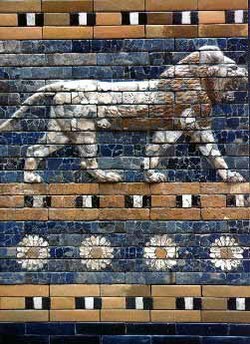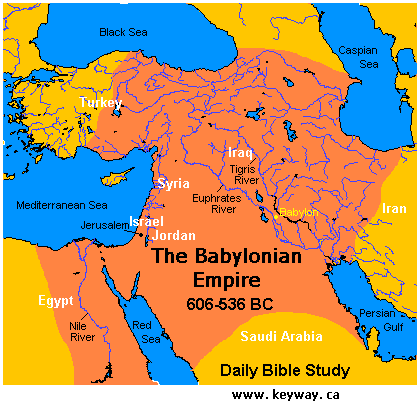Life in Mesopotamia - Babylon City
- Founded in 1867 BC by an Amorite dynasty
- Along with Assyria to the north, was one of the two Akkadian nations that evolved after the collapse of the Akkadian Empire
- The city was built upon the Euphrates, and divided in equal parts along its left and right bank.
- Artistic
 |
| Detail of the Ishtar Gate |
In the pre-Sargonic period, almost all the available material is that in stone and metal found at Shirpurla. The whole, while full of simplicity and vigor, is crude and rough. In mastery of his material
the artist has made much progress since the early days. The impression given is one of severe simplicity, directness, attention to detail, and concentrated power.
- Social
 Babylonian society consisted of three classes represented by the awilu - a free person of the upper class; the mushkenu - a free person of low estate and the wardu, or slave. Most slaves were prisoners of war, but some were recruited from the Babylonian citizenry. For example, free person might be reduced to slavery as punishment for certain offenses or parents could sell their children as slaves in time of need, but for no longer than three years. Slaves were the property of their master and usually were well treated. They had certain legal rights and could engage in business, borrow money, and buy their freedom. If a slave married a free person and had children, the latter were free.
Babylonian society consisted of three classes represented by the awilu - a free person of the upper class; the mushkenu - a free person of low estate and the wardu, or slave. Most slaves were prisoners of war, but some were recruited from the Babylonian citizenry. For example, free person might be reduced to slavery as punishment for certain offenses or parents could sell their children as slaves in time of need, but for no longer than three years. Slaves were the property of their master and usually were well treated. They had certain legal rights and could engage in business, borrow money, and buy their freedom. If a slave married a free person and had children, the latter were free. - Political
During the reigns of Hammurabi and his son Samsu-iluna, Babylonian civilization reached the zenith of its cultural development and political power. Toward the middle of the 16th century BC, a Kassite ruler named Agum became master of Babylonia and extended its territory from the Euphrates River to the Zagros Mountains. At the beginning of the 15th century BC, it was one of the four major powers of the Orient. Early in the 14th century BC, Assyrian rulers began to interfere in the affairs of Babylonia and sought to control it politically. Babylonia became so weak. A revolt then broke out in southern and central Babylonia, and a new dynasty was founded. For about two centuries thereafter the country was in a state of political chaos.
- Intellectual
Such phrases as cuneiform civilization, cuneiform literature, and cuneiform law can apply only where people had had the idea of using soft clay not only for bricks and jars and for the jar stoppers on which a seal could be impressed as a mark of ownership but also as the vehicle for impressed signs to which established meanings were assigned - an intellectual achievement that amounted to nothing less than the invention of writing.
- Religious
 |
| The Ancient Hanging Gardens of Babylon |
Religion in Ancient Babylon was divided between the state’s religion and the private citizen’s religion. The religion of the state involved huge followings that were very much cult-like and there were grand temples devoted to the religion of the state. Private individuals also sometimes followed a different type of religion, which involved sorcery and magic. There was no one god in the state religion but rather, many different gods, one for each city. The importance and power of a god was determined based on the political importance and power of the city for each particular god.
- Economic
| Babylon in 1932 |
That which grew in the field was the main basis for the economy of Ancient Babylon. The main crops that were grown were barley, wheat, fruit, vegetables, and cattle and sheep were their main sources of meat. Irrigation was crucial to the survival of the Babylonians. Not having banks available to them in ancient Babylon, the temples acted as financial institutions and the palace was considered to be a prime institution for financial matters. Babylonians rarely used the currency of ancient Babylon, instead working on a barter system that did not require the exchange of money.

No comments:
Post a Comment